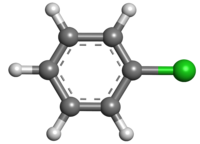Chlorobenzene
|
|
|||
 |
|||
| Names | |||
|---|---|---|---|
|
IUPAC name
chlorobenzene
|
|||
| Other names
benzene chloride
monochlorobenzene Phenyl chloride Chlorobenzol MCB |
|||
| Identifiers | |||
|
108-90-7 |
|||
| 3D model (Jmol) | Interactive image | ||
| Abbreviations | PhCl | ||
| ChEBI |
CHEBI:28097 |
||
| ChEMBL |
ChEMBL16200 |
||
| ChemSpider |
7676 |
||
| ECHA InfoCard | 100.003.299 | ||
| KEGG |
C06990 |
||
| PubChem | 7964 | ||
| RTECS number | CZ0175000 | ||
| UNII |
K18102WN1G |
||
|
|||
|
|||
| Properties | |||
| C6H5Cl | |||
| Molar mass | 112.56 g/mol | ||
| Appearance | colorless liquid | ||
| Odor | almond-like | ||
| Density | 1.11 g/cm³, liquid | ||
| Melting point | −45 °C (−49 °F; 228 K) | ||
| Boiling point | 131 °C (268 °F; 404 K) | ||
| 0.5 g l−1 in water at 20 °C | |||
| Solubility in other solvents | soluble in most organic solvents | ||
| Vapor pressure | 9 mmHg | ||
| -69.97·10−6 cm3/mol | |||
| Hazards | |||
| Safety data sheet | See: data page | ||
| R-phrases | R10 R20 R51/53 | ||
| S-phrases | S24/25 S61 | ||
| NFPA 704 | |||
| Flash point | 29 °C (84 °F; 302 K) | ||
| Explosive limits | 1.3%-9.6% | ||
| Lethal dose or concentration (LD, LC): | |||
|
LD50 (median dose)
|
2290 mg/kg (rat, oral) 2250 mg/kg (rabbit, oral) 2300 mg/kg (mouse, oral) 2250 mg/kg (guinea pig, oral) |
||
|
LCLo (lowest published)
|
8000 ppm (cat, 3 hr) | ||
| US health exposure limits (NIOSH): | |||
|
PEL (Permissible)
|
TWA 75 ppm (350 mg/m3) | ||
|
REL (Recommended)
|
none | ||
|
IDLH (Immediate danger)
|
1000 ppm | ||
| Related compounds | |||
|
Related Halobenzenes
|
Fluorobenzene Bromobenzene Iodobenzene |
||
|
Related compounds
|
benzene 1,4-dichlorobenzene |
||
| Supplementary data page | |||
|
Refractive index (n), Dielectric constant (εr), etc. |
|||
|
Thermodynamic
data |
Phase behaviour solid–liquid–gas |
||
| UV, IR, NMR, MS | |||
|
Except where otherwise noted, data are given for materials in their standard state (at 25 °C [77 °F], 100 kPa).
|
|||
|
|
|||
| Infobox references | |||
Chlorobenzene is an aromatic organic compound with the chemical formula C6H5Cl. This colorless, flammable liquid is a common solvent and a widely used intermediate in the manufacture of other chemicals.
The major use of chlorobenzene is as an intermediate in the production of commodities such as herbicides, dyestuffs, and rubber. Chlorobenzene is also used as a high-boiling solvent in many industrial applications as well as in the laboratory. Chlorobenzene is nitrated on a large scale to give a mixture of 2-nitrochlorobenzene and 4-nitrochlorobenzene , which are separated. These mononitrochlorobenzenes are converted to related 2-nitrophenol, 2-nitroanisole, bis(2-nitrophenyl)disulfide, and 2-nitroaniline by nucleophilic displacement of the chloride, with respectively sodium hydroxide, sodium methoxide, sodium disulfide, and ammonia. The conversions of the 4-nitro derivative are similar.
Chlorobenzene once was used in the manufacture of certain pesticides, most notably DDT by reaction with chloral (trichloroacetaldehyde), but this application has declined with the diminished use of DDT. At one time, chlorobenzene was the main precursor for the manufacture of phenol:
It was first described in 1851. Chlorobenzene is manufactured by chlorination of benzene in the presence of a catalytic amount of Lewis acid such as ferric chloride, sulfur dichloride, and anhydrous aluminium chloride:
...
Wikipedia



